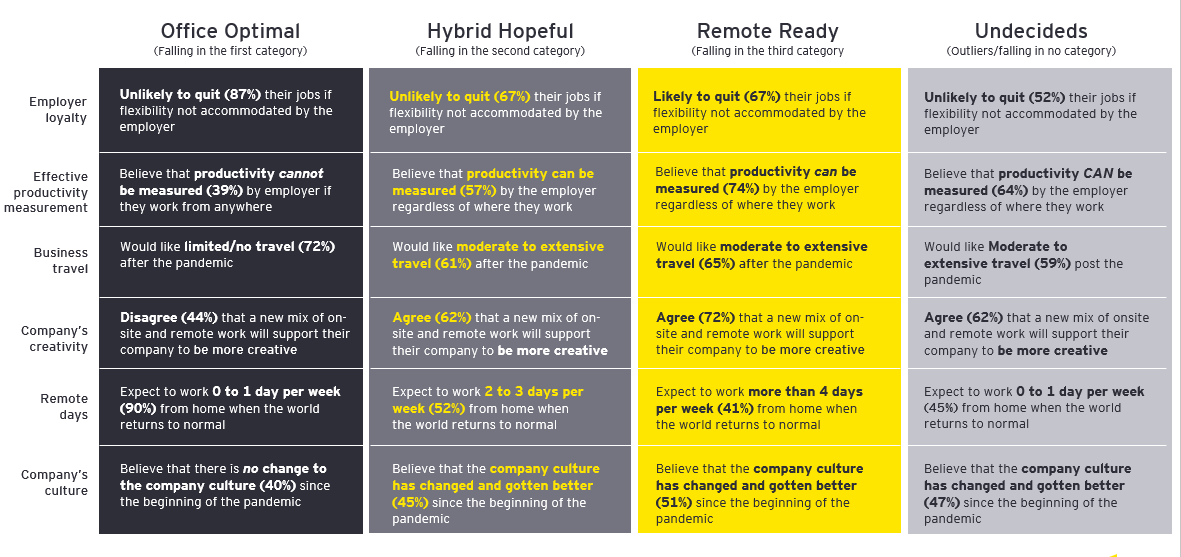Not all organizations will look exactly the same, which is why employee listening is key. That includes everything from soliciting one-on-one feedback to employee experience surveys.
If you’re going to listen to what employees want, you must also be willing to act on what you learn. As companies learn more, they’re scrambling to renegotiate contracts to offer more flexible start and finish times, shorter working weeks and innovative rewards.
The risks of not taking action are high, with 54% of employees stating they’re likely to quit if they aren’t offered the flexibility they want.
2. Focus on organizational culture
While the stress of change can take its toll, it also brings opportunity. Almost half of employees believe their company culture has changed and improved since the beginning of the pandemic.
Today’s organizations have a chance to redefine their purpose by deciding who they want to be and what kind of culture they want to build. Some businesses have gone fully remote. For others, that’s just not realistic. It’s a decision that can be enabled by workforce analytics, taking into account the successes of remote working and any relevant data points.
Once companies understand the demographics and how they’ll set up their flexible arrangements, they need a clear set of guiding principles with clear expectations
3. Work towards a new type of leadership
Managing through change requires a different kind of leadership — leadership that puts humans at the centre of the business. Approximately 82% of the employees we surveyed say it’s important for their organizations to see them as a person, not just as an employee. And while 9 in 10 employers say they put humans at the centre of long-term plans for value creation, fewer than 69% of employees believe them.
To support the new organizational culture they’re trying to build, companies must focus on leadership behaviour. Empathy, resilience and compassion are all key enablers for a flexible working environment, but they have to be genuine to be effective. A big part of empathetic leadership is communicating regularly and showing vulnerability. It’s okay to not have all the answers at this stage, and for organizations to say, “we’re learning as we go.” Or, better yet, to include employees in the broader discussion of who they want to become. That way, they feel valued and invested in future plans.
A recent EY study on empathy in business also found that employees suggested regularly scheduled one-on-ones, opportunities to provide anonymous feedback and team-building exercises as a way to build trust and a culture of openness.
4. Ensure your people are equipped with the tools, skills and mindsets to enable them to transition and then thrive
If workplace transformation requires a different kind of leadership, it also requires a different kind of teaming. Enhancing collaboration in a hybrid work environment is uncharted territory for many. Turning on a video function for added connectivity, ensuring materials are accessible and available to everyone and finding ways to explore everyone’s ideas equally are all effective tactics for better inclusion.
One of the biggest challenges in creating a flexible work environment is ensuring employees have a seamless experience around tools, technology and collaboration.
We know from our EY Work Reimagined Employee Survey that 84% of employees are looking for better digital tools to support their hybrid working arrangements. Nearly two thirds (64%) want better technology in the office, including faster internet and videoconferencing. Almost half (48%) say they want companies to upgrade at-home hardware — including extra monitors and headsets — and 47% would like reimbursement for high-speed internet and phone expenses.
Beyond tools, companies also need to ensure managers know how to lead and manage expectations and performance as work arrangements shift. A permanent remote worker will require different management styles than someone who is present in the office every day.
Access to learning and the ability to learn within the flow of work is also critical. Organizations should ask: do we have an effective learning experience platform? And do employees have access to a career path that tells them they’re valued?
To shift to more a empathetic leadership style, leaders need to create a safe space for better career conversations. Coaching is an effective way to do that because it’s typically removed from the formal performance relationship or business hierarchy.
EY recently launched a new coaching solution that allows our clients to make effective coaching accessible to their people. The programs are targeted to roles and levels where rapid behaviour change is needed to enable strategy — from executive levels to frontline managers.
For example, challenge leaders to develop and take action against personalized development plans. Guide teams of leaders through a structured approach to help their teams excel and deliver better results. Or coach at scale, applying a broad-reaching approach to bring a culture of transformative leadership to the whole organization.
Enabling transformation through people
Flexibility is no longer a differentiator — it’s an expectation that must become part of an organization’s culture. Today’s differentiator is when organizations are able to support their people through change by creating a human-centred experience.
Transformation can’t happen without people driving it. Employers need to not only put talent at the core of their strategy, but demonstrate that commitment to their workforce with transparency and authenticity.


